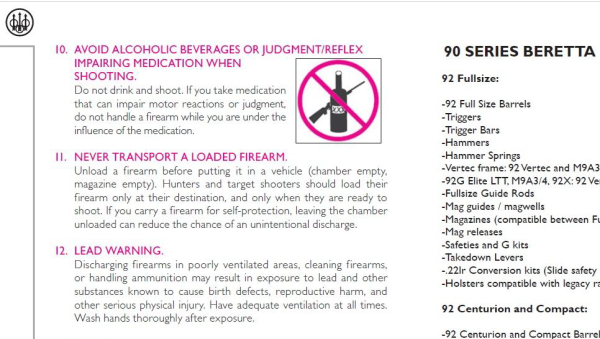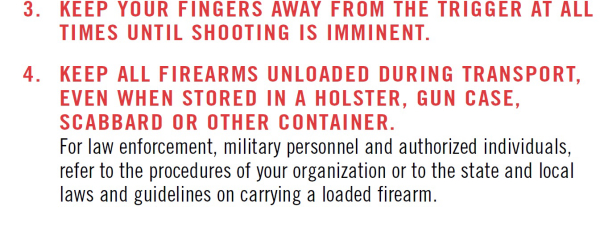Editor’s Note –If you have an interest in revolver content, let us know – at info@thetacticalwire.com; put “Revolver Special Edition” in the subject line. It’s been some time since the Outdoor Wires ran a special edition. It may be time to do one now. Let us know –
Read the Manual
If you don’t recall the gamey acronym, look it up. I’ll help a little here – if you don’t know how something works, “read your ******* manual.”
I can guess how many people on social media read the manuals accompanying firearms. The number is very small. I know that because SIG “suddenly” put a disclaimer in the manual for the P320 – don’t load it until you need to shoot. This has become “a thing” due to all the flak about the P320 and “uncommanded discharges.”

These aren’t new manuals; both counsel carrying the gun half-loaded. Neither are SIG – but they do it too and have for years.
I first read a similar warning in an owner’s manual printed in the 1960s – and in about every accompanying manual since. Want some examples?
These are screenshots of manuals from the error-net. Find one, excluding the interesting language in the FN manual, that doesn’t warn “don’t load the chamber until ready to use.” And none of these manuals were composed in Israel, formerly the home of Condition Three – along with the US Army.

The manual segment above is for the FN 509, the language is enlightened. The segment below is from an early version of the SIG P320 manual.
Here we know that a half-loaded gun is nearly worthless and we know why. It’s not just the time it takes to load it; it’s a safety hazard. People handle half-loaded guns as if they’re unloaded. Don’t ask how I know this.
Just trust me.
Is the P320 an accident waiting to happen?
I don’t know. Like Richard Mann, I don’t see how it could happen. But I didn’t expect “81 million votes” (sic) either. So, anything couldhappen.
Relative Accuracy
What is accuracy? For my money, accuracy consists of two parts: (1) rounds grouping close together consistently (precision), (2) and hitting the intended mark – or close to it.
Is accuracy putting all shots in a group within 1 minute of angle (about one-inch at one hundred yards)? – It can be.
Is that the metric? – No. Accuracy (along with precision) is a relative term.
It’s not that there is no standard; it just varies as to intended use and the class of firearm used.
A discussion recently came to my attention where relative handgun accuracy was discussed. A rule of thumb was proposed, after which I recalled that Jeff Cooper opined that the service pistol, to be precise enough for the job, should strike its rounds within five-inches at fifty yards.
That doesn’t mean that you or I can hold within five-inches at fifty yards; the practical accuracy could be less – for some of us – while being tighter for others.

Expectations for accuracy precision can vary based on the firearm’s format and design.
To say that handguns are harder to shoot accurately than long guns could well be an understatement of enormous proportions. People are often surprised at “feats of accuracy” that are relatively humdrum for a good many practitioners.
Expectations play a role.
A pair of my uncles together for the holidays were opining about handgun accuracy once. Their selections for law enforcement handguns were, for 1974, I thought plebeian. I proposed that a smaller gun, more easily concealed, would fit the bill in most situations. They reminded me that tiny guns, with lousy sights and tough triggers – as well as that short sight radius – were “inaccurate.”

This two-inch Ruger LCRx 357 Magnum fired at 10 yards with Cor-Bon 110gr. JHP +P, double-action. Is it accurate enough?
Many years later, I was being told about the short sight radius problem – the idea being that a longer distance between mechanical sights allowed more error while giving acceptable results downrange. Having seen this expert shoot before, I silently reflected that sight radius was amongst the least of his problems in the accuracy department.
It’s like the once-a-year hunter (who fires three rounds to find his rifle “good enough”) railing about a particular new rifle being lauded in outdoors media; he notes that it’s not “minute of angle.”
Here’s someone who struggles to stay within ten minutes of angle – from a field shooting position – wanting a more accurate rifle.
You can’t buy your way to accuracy; you won’t hurt – necessarily – with a better trigger, better sights, etc. But if you don’t put in the effort, the expenditure lacks relevance.
When it’s handgun accuracy, the struggle can be worth the effort.
— Rich Grassi